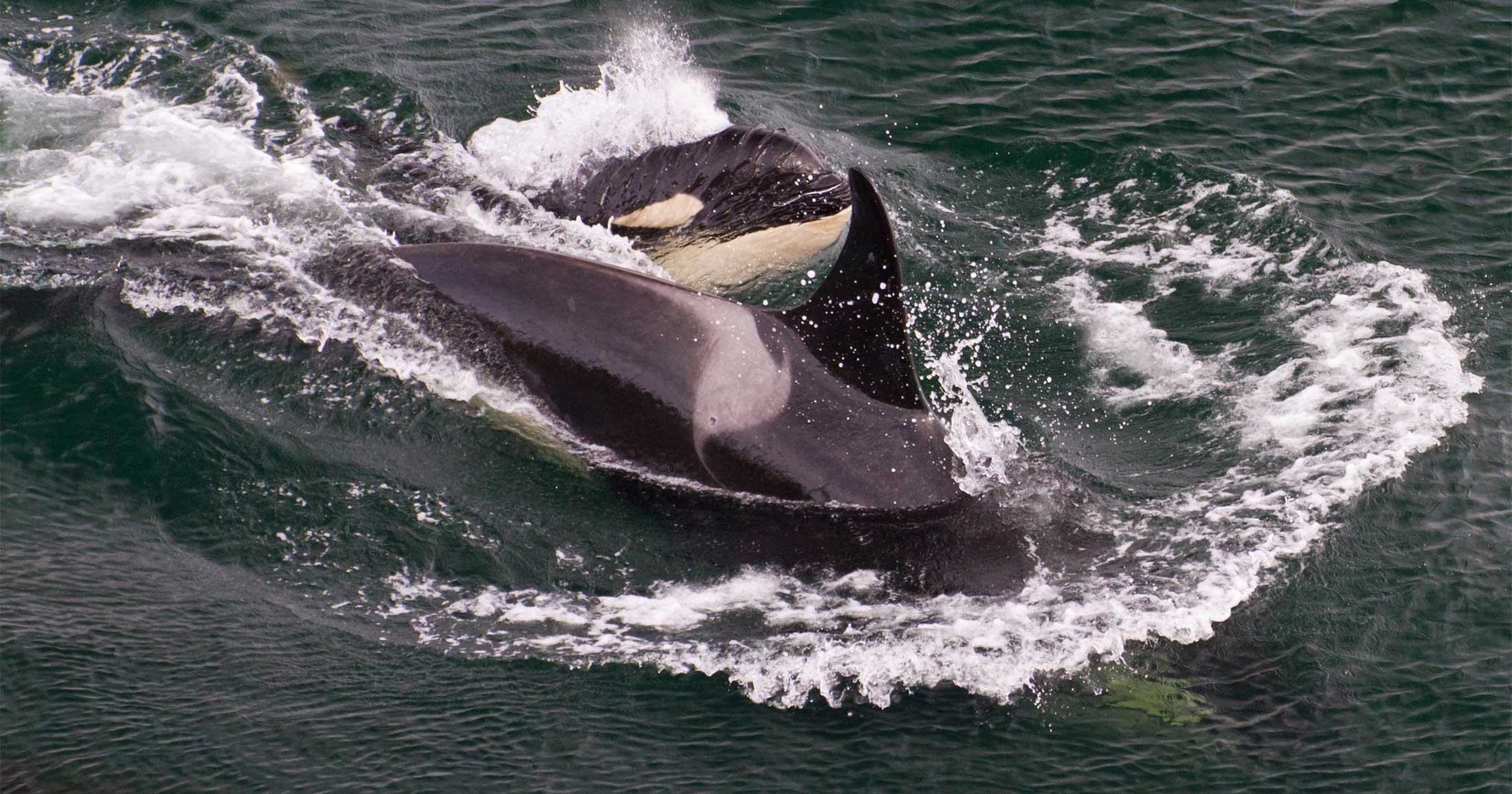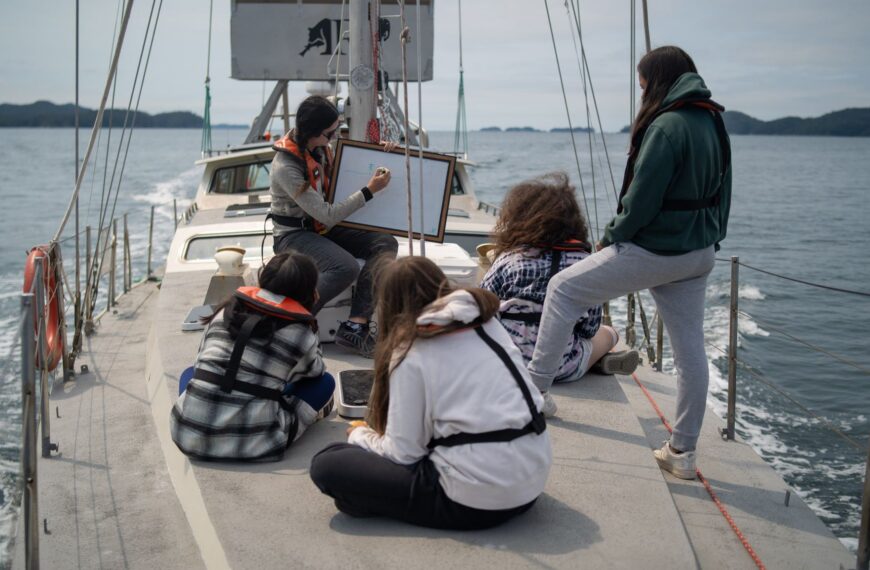Southern Resident killer whales not getting enough to eat since 2018
New research shows that Southern Residents have been in an energy deficit for six of the last 40 years.
The endangered Southern Resident killer whale population isn’t getting enough to eat, and hasn’t been since 2018, a new study, published in PLOS ONE, has determined.
The animals have been in an energy deficit, averaged across spring, summer, and fall, for six of the last 40 years—meaning the energy they get from food is less than what they would normally expend. Three of those six years came in the most recent years of the study, 2018 to 2020. The average difference in energy is 28,716 calories, or about 17 percent of the daily required energy for an average adult killer whale, the authors say.
“With the Southern Resident population at such a low level, there’s a sense of urgency to this kind of research,” says lead author Fanny Couture, a doctoral student at the Institute for the Oceans and Fisheries (IOF) and Ocean Wise. “Both killer whales and Chinook salmon, the Southern Resident’s main prey, are important, iconic species for the west coast of Canada. Studying what is happening to the population may help offer solutions, both for the Southern Residents and potentially other killer whale populations in the future.”
The Southern Resident population, which feeds mainly on Chinook salmon, numbered 73 individuals as of October 2021, compared with the increasing Northern Resident population of about 300. Studies have posited that the growth of the Southern Resident population may be impeded by a lack of food.
The researchers analyzed how changes in the abundance, age, and size of Chinook, coho and chum populations that the Southern Residents prey on in the Salish Sea and at the west coast of Vancouver Island influenced the daily food consumption of the killer whales, from 1979 to 2020 for three seasons each year.
The study used estimated declines in Chinook salmon abundance and size to show that lower availability of these fish has likely resulted in killer whale energy deficits. “The years where Southern Residents were in an energy deficit are also years where other studies report lower population growth rate and higher mortality rates for the killer whales,“ says co-author Dr. Villy Christensen, professor at IOF.
Previous research has shown correlations between Chinook salmon abundance and Southern Resident survival rate and fertility. The decline in Chinook salmon abundance could be attributed to many factors, says Couture, including the effects of climate change, greater susceptibility to disease, and predation by other animals.
The model also projected that Southern Residents would consume more chum salmon than Chinook during years where Chinook were at low levels, showing the animals could switch to other salmon species when the abundance of their primary prey declines.
“Despite the shortage of Chinook, the Southern Residents are unlikely to broaden their diet much,” said co-author Lance Barrett-Lennard, research scientist at the Raincoast Conservation Foundation. “One of the most interesting things about killer whales is the extreme specialization of different populations on specific prey. Like the neighbouring Northern Residents, the Southern Residents are very much Chinook specialists, with some chum salmon, coho salmon and sablefish thrown in–and nothing we know about killer whales indicates that that will change.”
The dire situation for Southern Resident killer whales may call for a reduction in the catch of larger Chinook salmon, which are predictors of whether the Southern Residents fall short energy-wise, said Dr. Christensen. This could include promoting fishing techniques that increase the survival of larger fish.
Other factors that could be influencing the availability of prey for the Southern Residents include underwater noise pollution from boats that could affect foraging, Couture says. This could be an area for future research. Researchers could also apply their model to the Northern Resident population to determine if they too have an energy deficit.
The model did not include winter, as it’s unclear where southern residents are during the season.
Citation
Couture F, Oldford G, Christensen V, Barrett-Lennard L, Walters C (2022) Requirements and availability of prey for northeastern pacific southern resident killer whales. PLoS ONE 17(6): e0270523. https://doi.org/10.1371/journal.pone.0270523
Abstract
The salmon-eating Southern Resident killer whale (SRKW) (Orcinus orca) population currently comprises only 73 individuals, and is listed as ‘endangered’ under the Species at Risk Act in Canada. Recent evidence suggests that the growth of this population may be limited by food resources, especially Chinook salmon (Oncorhynchus tshawytscha). We present spatio-temporal bioenergetics model for SRKW in the Salish Sea and the West Coast of Vancouver Island from 1979–2020 with the objective of evaluating how changes in the abundance, age-structure, and length-at-age of Chinook salmon populations has influenced the daily food consumption of the SRKW population. Our model showed that the SRKW population has been in energetic deficit for six of the last 40 years. Our results also suggested that the abundance of age-4 and age-5 Chinook salmon are significant predictors of energy intake for SRKW. We estimated that the annual consumption (April-October) of Chinook salmon by the whales between 1979 and 2020 ranged from 166,000 216,300. Over the past 40 years, the model estimated that the contribution in the predicted SRKW diet of Chinook salmon originating from the Columbia River has increased by about 34%, and decreased by about 15% for Chinook salmon stocks originating from Puget Sound. Overall, our study provides an overview of the requirements and availability of prey for SRKW over the last 40 years, while supporting the hypothesis that SRKW were limited by prey abundance in the study period.
Select figures

Authors and affiliations
Fanny Couture1,2, Greig Oldford1,3, Villy Christensen1, Lance Barrett-Lennard4, Carl Walters1
1. Institute for the Oceans and Fisheries, University of British Columbia, Vancouver, British Columbia, Canada
2. Ocean Wise Research Institute, Marine Mammals Research Program, Vancouver, British Columbia, Canada
3. Fisheries and Oceans Canada, Pacific Region, Vancouver, British Columbia, Canada
4. Raincoast Conservation Foundation, Cetacean Conservation Research Program, Sidney, British Columbia, Canada
You can help
Raincoast’s in-house scientists, collaborating graduate students, postdoctoral fellows, and professors make us unique among conservation groups. We work with First Nations, academic institutions, government, and other NGOs to build support and inform decisions that protect aquatic and terrestrial ecosystems, and the wildlife that depend on them. We conduct ethically applied, process-oriented, and hypothesis-driven research that has immediate and relevant utility for conservation deliberations and the collective body of scientific knowledge.
We investigate to understand coastal species and processes. We inform by bringing science to decision-makers and communities. We inspire action to protect wildlife and wildlife habitats.










